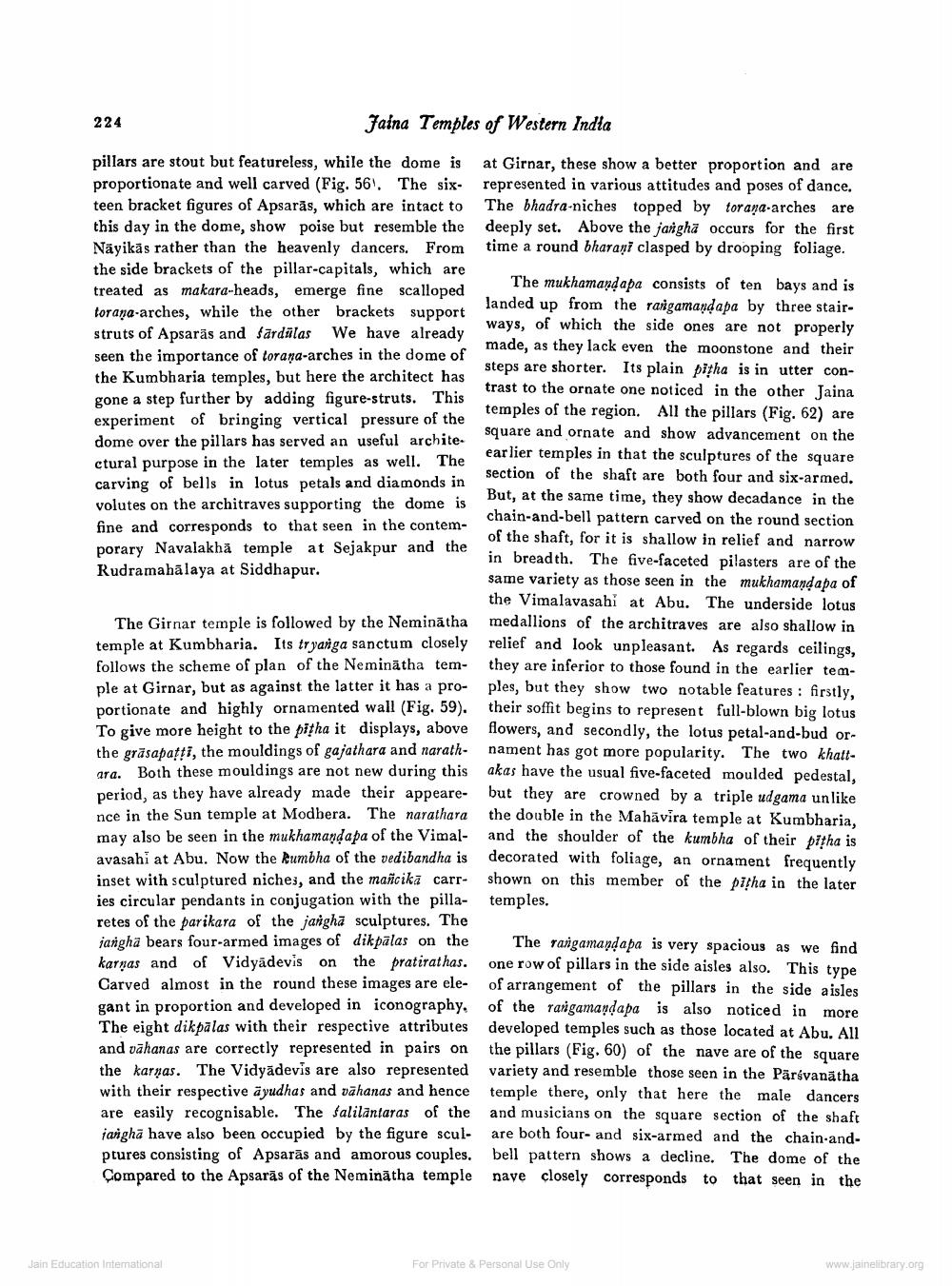________________
224
Jaina Temples of Western India
pillars are stout but featureless, while the dome is proportionate and well carved (Fig. 56. The six teen bracket figures of Apsaras, which are intact to this day in the dome, show poise but resemble the Nayikās rather than the heavenly dancers. From the side brackets of the pillar-capitals, which are treated as makara-heads, emerge fine scalloped torana-arches, while the other brackets support struts of Apsaras and färdülas We have already seen the importance of toraṇa-arches in the dome of the Kumbharia temples, but here the architect has gone a step further by adding figure-struts. This experiment of bringing vertical pressure of the dome over the pillars has served an useful architectural purpose in the later temples as well. The carving of bells in lotus petals and diamonds in volutes on the architraves supporting the dome is fine and corresponds to that seen in the contemporary Navalakha temple at Sejakpur and the Rudramahalaya at Siddhapur.
The Girnar temple is followed by the Neminatha temple at Kumbharia. Its tryanga sanctum closely follows the scheme of plan of the Neminatha temple at Girnar, but as against the latter it has a proportionate and highly ornamented wall (Fig. 59). To give more height to the pitha it displays, above the grasapaṭṭi, the mouldings of gajathara and narathara. Both these mouldings are not new during this period, as they have already made their appearence in the Sun temple at Modhera. The narathara may also be seen in the mukhamandapa of the Vimalavasahi at Abu. Now the Rumbha of the vedibandha is inset with sculptured niches, and the mañcika carries circular pendants in conjugation with the pillaretes of the parikara of the jangha sculptures. The jangha bears four-armed images of dikpalas on the karnas and of Vidyadevis on the pratirathas. Carved almost in the round these images are elegant in proportion and developed in iconography, The eight dikpälas with their respective attributes and vāhanas are correctly represented in pairs on the karnas. The Vidyadevis are also represented with their respective ayudhas and vahanas and hence are easily recognisable. The faliläntaras of the jangha have also been occupied by the figure sculptures consisting of Apsaras and amorous couples. Compared to the Apsaras of the Neminatha temple
Jain Education International
at Girnar, these show a better proportion and are represented in various attitudes and poses of dance. The bhadra-niches topped by toraṇa-arches are deeply set. Above the jangha occurs for the first time a round bharani clasped by drooping foliage.
The mukhamandapa consists of ten bays and is landed up from the ragamandapa by three stairways, of which the side ones are not properly made, as they lack even the moonstone and their steps are shorter. Its plain pitha is in utter contrast to the ornate one noticed in the other Jaina temples of the region. All the pillars (Fig. 62) are square and ornate and show advancement on the earlier temples in that the sculptures of the square
section of the shaft are both four and six-armed. But, at the same time, they show decadance in the chain-and-bell pattern carved on the round section of the shaft, for it is shallow in relief and narrow in breadth. The five-faceted pilasters are of the same variety as those seen in the mukhamandapa of the Vimalavasahi at Abu. The underside lotus medallions of the architraves are also shallow in relief and look unpleasant. As regards ceilings, they are inferior to those found in the earlier temples, but they show two notable features: firstly, their soffit begins to represent full-blown big lotus flowers, and secondly, the lotus petal-and-bud ornament has got more popularity. The two khattakas have the usual five-faceted moulded pedestal, but they are crowned by a triple udgama unlike the double in the Mahavira temple at Kumbharia, and the shoulder of the kumbha of their pitha is decorated with foliage, an ornament frequently shown on this member of the pitha in the later temples.
The rangamanḍapa is very spacious as we find one row of pillars in the side aisles also. This type of arrangement of the pillars in the side aisles of the rangamanḍapa is also noticed in more developed temples such as those located at Abu. All the pillars (Fig. 60) of the nave are of the square variety and resemble those seen in the Parsvanatha temple there, only that here the male dancers and musicians on the square section of the shaft are both four- and six-armed and the chain-andbell pattern shows a decline. The dome of the nave closely corresponds to that seen in the
For Private & Personal Use Only
www.jainelibrary.org




